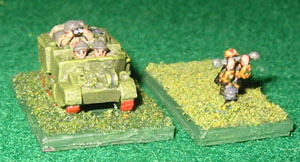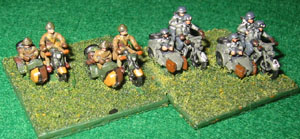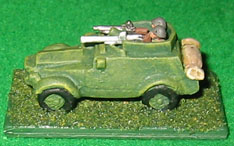Panzer8 Expansion Rules - February 2008
The following rules are not required to play the game but
can be added after experience has been gained with the basic
rules in order to add flavour and posibilities to the game.
Unless
specified by the scenario, it should be declared before the start of
the game which expansion rules are in use.
10. Advanced Elements

Forward Observer elements:
A Forward Observer element represents a radio (or telephone) equipped
team
used to control off-board support assests. This can be a
FOO (Forward Observation Officer) who controls indirect mortar,
artilley and naval gunfire,
or a FAC (Forward Air Controller)
who controls air support missions.
When dismounted they are represented by one or two men,
usually and officer with binoculars and sometimes an additional
radioman. These were often mounted; in some cases like the Soviets
they must remain truck mounted as they are not man-portable.
If a telephone equipped FOO moves, then it may no longer function as an
FOO. These are not considered to
be combat elements.
|

Motorcycle elements: Three or four
models (two with
side-cars) should
be grouped on a base to represent a section.
Bicycle elements: These are treated
exactly as
infantry elements except
they move at +2 on roads.
|
Cavalry elements: Three or four models should be
grouped on a base to
represent a section (contemporary photographs show cavalry operating in
tight formations). Crew-served weapons attached to cavalry units were
often mounted on horse-drawn wagons which can be represented by
transport or portee elements as appropriate. Cavalry move as mechanised
elements. Cavalry that initiate close
combat against elements in open, fields with high crops or dug-in gain
a +2 HE/SA modifier.
10.1 Dismounting
Mounted troops such as Cavalry
and Motorcycles are normally represented by models in
their mounted
state.They may dismount during the movement phase taking the entire
phase
to do so. Once dismounted the mounted element is replaced by an
equivalent
infantry section.
A base of mounts without riders may optionally be
provided, and if so it is
placed anywhere adjacent to the troops that dismount. This is a non
combat element which may not move. A typical such base could
consist
of a group of horses with horse-holders.
If the dismounted unit is contiguous with its base of mounts, then it
may remount during the movement phase, taking an entire phase to do so.
Portee elements may dismount as the equivalent Crew Served
Weapons.
If an empty transport marker is provided, then they may remount.
10.2 Reconnaissance troops
 Some elements are classed as Recce. These are often
armoured cars but can even be such elements as light tanks,
cavalry, motorcycles or infantry scouts. They represent
troops specially trained in scouting.
Some elements are classed as Recce. These are often
armoured cars but can even be such elements as light tanks,
cavalry, motorcycles or infantry scouts. They represent
troops specially trained in scouting.
Recce elements gain advantages when locating hidden enemy.
Unless the scenario specifies otherwise, recce units may move
once after the game has been setup but before the game starts.
If both sides have recce units they alternately move one element
each; starting with the defender, randomly if there isn't a defender.
Recce elements due to enter the table on the first game
turm may use this extra movement to enter the board.
11. Hidden Placement
Unless otherwise specified, in a scenario with an attacker and
defender, the defender can use
hidden placement for up to half of his elements. Other scenarios may
permit hidden placement. To use hidden placement the element must be in
cover, and not in permanent fortifications. A hidden element
is
always revealed when it fires, moves or when an enemy element
moves with
range 2. Hidden elements may not be fired upon in the normal
manner, instead
speculative fire with a range of 12 may be directed at the hidden
element to make it
reveal
itself. Roll 1d20 and score of 12+ to succeed (troop quality
modifiers apply). If a non-recce element is spotting, a -3 modifier
applies. If
successful, any hidden elements are placed on the table.
Whether the defending player uses counters or map to record
the location of his hidden troops is a matter of taste.
11.1 Hidden Placement - Counters
The player places a counter on the table to represent one or more
elements. In
addition an equal number of “dummy”
counters may be
placed. Speculative fire may be directed any counter to which
the firer has LOS. When placed on the table, hidden elements
can have any desired facing or
position provided they touches the hidden marker.
11.2 Hidden Placement - Map
The player draws a map of the battlefield and marks the position of
each element. Speculative fire may be directed at any terrain
feature. If successful, only elements to which the firer would have a
LOS are revealed. When placed on the table, hidden elements can have
any desired facing.
12. APDS and HVAP Ammunition
The British and Americans had APDS
(Armoured Piercing Discarding Sabot) and HVAP (High Velocity Armoured
Piercing) ammunition in late 1944 and 1945. A specific scenario can
proscribe its use. Weapons capable of firing this ammunition have two
AP values, one for “normal” ammunition and one for
“improved” ammunition. The type of ammunition being
used must be declared before firing. Note that elements firing APDS or
HVAP must
use the ammunition supply rule, even if no other elements on the table
are using it..
13. Ammunition
Supply
Vehicle mounted weapons, crew served weapons and
flamethrowers
can run out of ammunition. Although this rule is optional,
flamethrowers, APDS or HVAP should not be used without it. An
unmodified 1 on the AP to-hit or HE/SA table causes the weapon to run
out of
ammunition. Germans in 1945, Soviets in 1941, flamethrowers and
elements firing APDS
or HVAP are out of ammunition on rolls of 1 or 20. An
Anti-tank gun firing AP (as opposed to APDS, HVAP or HE)
never runs out of ammo.
Ammunition can be replenished by moving off table and
remaining
there for 1 entire turn, entering again at the place of departure. It
can also be replenished at an on-table supply dump and there remaining
stationary
without being fired upon for 1 entire turn. Guns with limbers can send
their limber to resupply without having to limber-up and move out
themselves.
14. Smoke
 Unless
specified otherwise by the scenario, only a limited number of smoke
screens may be placed. A pool of smoke "counters" is kept;
one for every AFV or infantry element fielded
(whichever is largest). Germans in 1945 and Soviets in 1941 have only
half this number. Every time smoke is fired, one counter it
is taken from the
pool regardless of the size of the smoke screen. Once the pool is
empty, no more smoke may be fired.
Unless
specified otherwise by the scenario, only a limited number of smoke
screens may be placed. A pool of smoke "counters" is kept;
one for every AFV or infantry element fielded
(whichever is largest). Germans in 1945 and Soviets in 1941 have only
half this number. Every time smoke is fired, one counter it
is taken from the
pool regardless of the size of the smoke screen. Once the pool is
empty, no more smoke may be fired.
Smoke lasts until the start of the player’s next fire phase
when it either dissipated or may be renewed (without requiring any die
roll).
- Smoke dischargers lay a two base-widths wide screen
touching
the front of the firer if hull mounted or any face if turret mounted.
An AFV may not advance through a smoke screen fired by friendly AFV
smoke dischargers.
- Sections with smoke grenades (usually
only assault engineers) can lay a two base-widths wide screen touching
the
unit.
- Sections with light mortars (provided with smoke
rounds) may fire a two base-widths wide screen. They must roll a 4 or
more on a D20 to succeed (troop quality modifiers apply). It may be
laid anywhere within range and LOS of the unit or its spotter.
- Sections with medium or heavy mortars may fire a three
base-widths wide screen. They must roll a 4 or more on a D20 to succeed
(troop quality modifiers apply). It may be laid anywhere within range
and LOS of the unit or its spotter
- Support fire may fire a smoke screen the size of its beaten
zone. When support fire is called using smoke, it counts as one support
mission in addition
to the smoke counter.
Firing at a unit that is within or beyond smoke gets a -4 modifier for
AP to-hit and HE/SA.
15 Support Fire
Support fire may be obtained from off-table batteries of guns,
rockets and mortars or even naval vessels. These can be firing to a
pre-arranged
schedule or be called in by radio, telephone and rocket or flare
equipped units on the ground. Support fire targets all units within,
even partially, or moving through a given area centred on a specified
map location. Players will be allocated a number of fire missions
(turns) that each battery can fire.
Support fire is called in or
cancelled during the command phase. A communications test must be made;
roll 1d20 and score 6+ to succeed (troop quality modifiers apply).
When calling in fire the duration, ammunition type (HE or smoke) and
the exact
location are marked on a map. Called in fire arrives in a later turn
during the fire phase. The number of turns delay depends on the level
at which the unit
performing the support fire is attached.
A Forward Observation Officer (FOO) can be
used to call in fire on any position in his LOS. The FOO can be
telephone equipped in which case he must be stationary and either
dug-in or in a building. The FOO can be radio equipped in which can he
can be on foot or mounted in a vehicle (lorry, halftrack, tank etc.).
French and Soviet
FOOs prior to 1944 must be telephone equipped. Soviet FOOs from Guard
Tank units may be radio equipped from summer
1944 but then must be in a lorry which they may not leave. Commander
elements can perform some of the tasks of a FOO, but not as well and
never for the Soviets.
Pre-Planned Bombardments must be marked on a map together with
the turn
on which they commence, duration, and ammunition type (HE or smoke).
They can be cancelled
(but not moved or delayed) by a FOO or Commander element with
a LOS to the planned location.
Final Defensive Fire (FDF) may be used by a side specified by
the
scenario as defending. Three locations are pre-registered for fire to
protect defensive positions. FDF can be called in by a FOO, commander
or combat element with a LOS to the location. If an FOO calls in FDF
then
the delay is reduce by one turn for brigade or higher levels. The
duration must also be recorded although this can be changed if called
in by a FOO or commander.
The British may use rolling barrages for support and
pre-planned
bombardments. The location of this moves a specified direction and
distance each turn; both of which must be specified when the barrage is
called/planned.
Fire can be obtained from different levels:
| Attached level |
Fire Missions |
HE/SA |
Beaten
Zone |
Delay |
Description |
| Battalion |
5 |
7 |
3 x 3 |
1 turn |
Usually medium mortars or light infantry
guns from the battalion support company |
| Brigade |
4 |
8 |
4 x 4 |
2 turns |
Usually a regimental gun company or attached
artillery battery |
| Division |
3 |
9 |
4 x 4 |
3 turns |
From the division’s artillery
battalions |
| Corps or Naval |
3 |
10 |
6 x 6 |
4 turns |
Heavy artillery or rockets |
Support fire is resolved as HE/SA fire. Support fire normally
has little or no effect on
AFVs and should be resolved as mortar fire. However Corps or Naval
level support
fire effects all vehicles regardless of armour value.
17. Field Engineering
17.1 Barbed Wire
 For
games purpuses, barbed wire is deployed in sections with a length four
times, and a width one times, the normal infantry element base
size.
For
games purpuses, barbed wire is deployed in sections with a length four
times, and a width one times, the normal infantry element base
size.
Fully tracked AFVs ignore barbed wire, as do infantry moving
directly behind them. Others stop on contact. It may then be crossed on
a subsequent turn by expending full movement.
Engineers may clear a one element wide path through barbed
bire.
They must remain stationary one whole turn adjacent to the wire. The
their subsequent fire phase, the must role a 12 or more to clear a path.
17.2 Permanent Fortifications - Bunkers & Pill boxes
 Unless specified
otherwise by the
scenario, a pill box can contain one and a bunker two
elements. These can be infantry, SFMG or guns. Mortars,
anti-aircraft guns and vehicles may not be placed in fortifications
although they may be dug in.
Unless specified
otherwise by the
scenario, a pill box can contain one and a bunker two
elements. These can be infantry, SFMG or guns. Mortars,
anti-aircraft guns and vehicles may not be placed in fortifications
although they may be dug in.
Troops in fortifications cannot be affected by small arms
fire. Only infantry and engineers may move into close combat with a
fortification.
Troops in fortifications gain the following cover
modifiers...
| Modifier... |
Enemy element type... |
| 0 |
Engineers in close combat or with flamethrowers |
| +2 |
Divebombers |
| +6 |
All other troop types |


 Some elements are classed as Recce. These are often
armoured cars but can even be such elements as light tanks,
cavalry, motorcycles or infantry scouts. They represent
troops specially trained in scouting.
Some elements are classed as Recce. These are often
armoured cars but can even be such elements as light tanks,
cavalry, motorcycles or infantry scouts. They represent
troops specially trained in scouting.
 Unless
specified otherwise by the scenario, only a limited number of smoke
screens may be placed. A pool of smoke "counters" is kept;
one for every AFV or infantry element fielded
(whichever is largest). Germans in 1945 and Soviets in 1941 have only
half this number. Every time smoke is fired, one counter it
is taken from the
pool regardless of the size of the smoke screen. Once the pool is
empty, no more smoke may be fired.
Unless
specified otherwise by the scenario, only a limited number of smoke
screens may be placed. A pool of smoke "counters" is kept;
one for every AFV or infantry element fielded
(whichever is largest). Germans in 1945 and Soviets in 1941 have only
half this number. Every time smoke is fired, one counter it
is taken from the
pool regardless of the size of the smoke screen. Once the pool is
empty, no more smoke may be fired.
 For
games purpuses, barbed wire is deployed in sections with a length four
times, and a width one times, the normal infantry element base
size.
For
games purpuses, barbed wire is deployed in sections with a length four
times, and a width one times, the normal infantry element base
size.  Unless specified
otherwise by the
scenario, a pill box can contain one and a bunker two
elements. These can be infantry, SFMG or guns. Mortars,
anti-aircraft guns and vehicles may not be placed in fortifications
although they may be dug in.
Unless specified
otherwise by the
scenario, a pill box can contain one and a bunker two
elements. These can be infantry, SFMG or guns. Mortars,
anti-aircraft guns and vehicles may not be placed in fortifications
although they may be dug in.